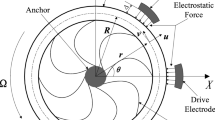Abstract
This paper presents a mathematical model for an imperfect ring gyroscope exhibiting spatial variations of the mass and stiffness of the ring arising from manufacturing imperfections and simulates the dynamics of the resonating ring dictating its performance under practical operating conditions. Actual tests performed on real devices involve significant costs and procedures, so the work aims to achieve the same aim with high fidelity models. The model used investigates the effects of shock and frequency splits between the drive and sense modes on the performance of the sensor in relation to the extent of the spatial mass and stiffness variations in the resonating ring. Severe reductions in shock tolerance are observed at shorter shock pulse durations. Small frequency splits between the drive and sense modes have minimal effects on the shock tolerance and the ring’s sense mode amplitude when excited electrostatically, but sharply increase the zero-rate readout (bias) and decrease the sensor’s sensitivity to angular velocity changes (scale factor). The extent of the tolerable frequency splits is limited by the half-power bandwidth of the sense mode, which is predominantly influenced by the system damping.











Similar content being viewed by others
References
Acar C, Shkel A (2009) MEMS vibratory gyroscopes: structural approaches to improve robustness. Springer, New York
Chang C-O, Chang G-E, Chou C-S, Chien W-TC, Chen P-C (2008) In-plane free vibration of a single-crystal silicon ring. Int J Solids Struct 45(24):6114–6132. https://doi.org/10.1016/j.ijsolstr.2008.07.033
Kawiecki G (2001) Modal damping measurement for damage detection. Smart Mater Struct 10(3):466–471. https://doi.org/10.1088/0964-1726/10/3/307
Langmaid C (1996) Vibrating structure gyroscopes. Sensor Rev 16(1):14–17. https://doi.org/10.1108/02602289610108357
Ning L, Zhong S, Qing L, MengYin F, Hong L, JunFang F (2013) Characterization of the bell-shaped vibratory angular rate gyro. Sensors 13(8):10123–10150. https://doi.org/10.3390/s130810123
Prikhodko I, Zotov SA, Trusov AA, Shkel AM (2012) Foucault pendulum on a chip: rate integrating silicon MEMS gyroscope. Sens Actuators A 177:67–78. https://doi.org/10.1016/j.sna.2012.01.029
Rourke AK, McWilliam S, Fox CHJ (2002) Multi-mode trimming of imperfect thin rings using masses at pre-selected locations. J Sound Vib 256(2):319–345. https://doi.org/10.1006/jsvi.2001.4211
Serrano DE, Zaman MF, Rahafrooz A, Hrudey P, Lipka R, Younkin D, Nagpal S, Jafri I, Ayazi F (2016) Substrate-decoupled, bulk-acoustic wave gyroscopes: design and evaluation of next-generation environmentally robust devices. Microsyst Nanoeng 2(1):16015. https://doi.org/10.1038/micronano.2016.15
Tehrani, PT, Izyumin O, Izyumin I, Ahn CH, Ng EJ, Hong VA, Yang Y, Kenny TW, Boser BE, Horsley DA (2015) Disk resonator gyroscope with whole-angle mode operation. IEEE Int Symp Inertial Sens Syst (ISISS). IEEE, Hapuna Beach. https://doi.org/10.1109/isiss.2015.7102360
Tsai N-C, Sue C-Y (2010) Experimental analysis and characterization of electrostatic-drive tri-axis micro-gyroscope. Sens Actuators A 158(2):231–239. https://doi.org/10.1016/j.sna.2010.01.005
Weng J-H, Chieng W-Hua, Lai J-Min (2005) Structural design and analysis of micromachined ring-type vibrating sensor of both yaw rate and linear acceleration. Sens Actuators A 117(2):230–240. https://doi.org/10.1016/j.sna.2004.06.016
Xin Z, Yu-lie W, Xue-zhong W, Yong-meng Z, Yu Z (2016) A novel ring gyroscope based on side-piezo electrodes. J Cent South Univ 23(3):555–561. https://doi.org/10.1007/s11771-016-3102-4
Yoon SW (2009) Vibration isolation and shock protection for MEMS. Ph.D. Thesis, Electrical Engineering, University of Michigan
Yoon SW, Lee S, Najafi K (2011) Vibration sensitivity analysis of MEMS vibratory ring gyroscopes. Sens Actuators A 171(2):163–177. https://doi.org/10.1016/j.sna.2011.08.010
Young WC, Budynas RG (2002) Roark’s formulas for stress and strain. 7. McGraw-Hill, New York
Zhang Wen-Ming, Yan Han, Peng Zhi-Ke, Meng Guang (2014) Electrostatic pull-in instability in MEMS/NEMS: a review. Sens Actuators A 214:187–218. https://doi.org/10.1016/j.sna.2014.04.025
Zhuravelev VPh (2015) On the precession of the elliptic mode shape of a circular ring owing to nonlinear effects. Mech Solids 50(1):1–5. https://doi.org/10.3103/S002565441501001X
Acknowledgements
The author would like to thank Dr. Stewart McWilliam (University of Nottingham) for the supervision of this research work.
Author information
Authors and Affiliations
Corresponding author
Ethics declarations
Conflict of interest
The author declares that there is no conflict of interest.
Additional information
Publisher's Note
Springer Nature remains neutral with regard to jurisdictional claims in published maps and institutional affiliations.
Rights and permissions
About this article
Cite this article
Jie, D. Simulating the performance of ring-based coriolis vibrating gyroscopic sensors. Microsyst Technol 25, 139–149 (2019). https://doi.org/10.1007/s00542-018-3944-9
Received:
Accepted:
Published:
Issue Date:
DOI: https://doi.org/10.1007/s00542-018-3944-9




